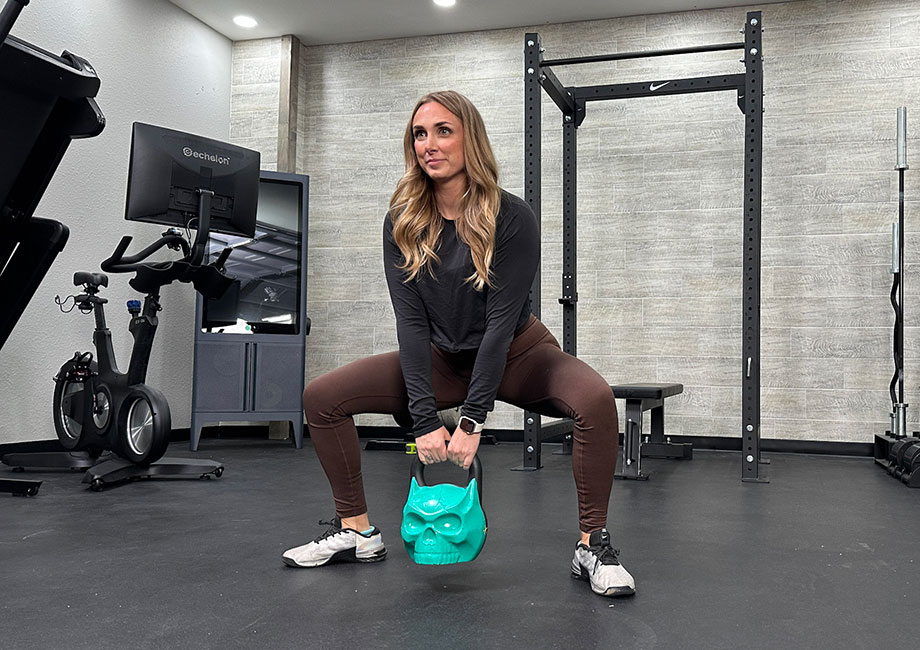We test and review fitness products based on an independent, multi-point methodology. If you use our links to purchase something, we may earn a commission. Read our disclosures.
Deadlifts are one of the most popular powerlifting exercises around. This compound exercise activates the muscles in the posterior chain (including the lower back, glutes, hamstrings, and calves), as well as other muscles in the body. Doing deadlifts expends a large amount of calories1 and may yield improvements in both pain and function2 for those living with low back pain.
There are several deadlift variations, including the Romanian deadlift, deficit deadlift, trap-bar deadlift, and sumo deadlift. Today’s focus is on the sumo deadlift. I’ll explain how to perform the movement, along with benefits, common mistakes, and variations for you to try.
How To Do The Sumo Deadlift Exercise
Muscles worked: Lower back, glutes, hamstrings, quadriceps, calves, trapezius
- Load the barbell with the required weight, then step underneath it with your feet wide apart (around two times your shoulder width). You’ll want your toes pointing slightly outward and the bar close to your shins.
- Grab the bar with either an overhand grip or a mixed grip, with your arms and hands inside of your legs.
- Stick your chest up, brace your core, then push your heels into the ground to lift the barbell off the ground.
- Keep lifting the bar until you stand upright, squeezing your glutes at the top.
- Reverse the motion by slowly returning the bar to the floor.
- Continue for the desired number of reps.
RELATED: Best Olympic Barbells
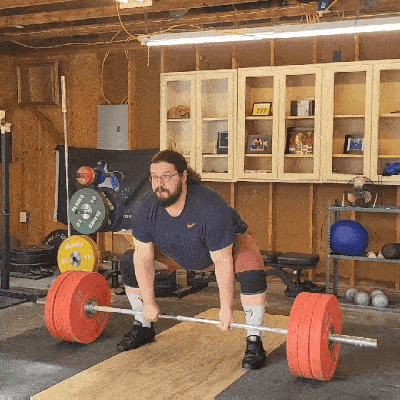
Trainer Tips for Form
Below are four tips to help you do the sumo deadlift the right way based on my experience as a certified personal trainer (CPT):
Take Your Time
There’s no rush when it comes to doing the sumo deadlift. It’s important to take your time to set up correctly, especially when lifting heavy loads. Ensure your stance is comfortable and you’re set up symmetrically on the bar. Speaking from experience here—the calmer you are before the lift, the easier it will feel.
Push Your Knees Out
Similar to the barbell squat, you’ll want to push your knees out and in line with your toes during the movement. There are two reasons why. Firstly, it’ll help you feel more stable, meaning you’re less likely to get pain in your knee joints. Pushing your knees out also means your hips are closer to the bar, making it easier to lift the bar off the ground.
RELATED: Proper Squat Form
Squeeze the Bar
If you don’t use lifting straps (more on this below!), your grip is likely to give in before the muscles in your posterior chain do. One way to get around this is to squeeze the bar as firmly as possible, especially during heavy weights. This may give you another rep or two that you wouldn’t have otherwise been able to do.
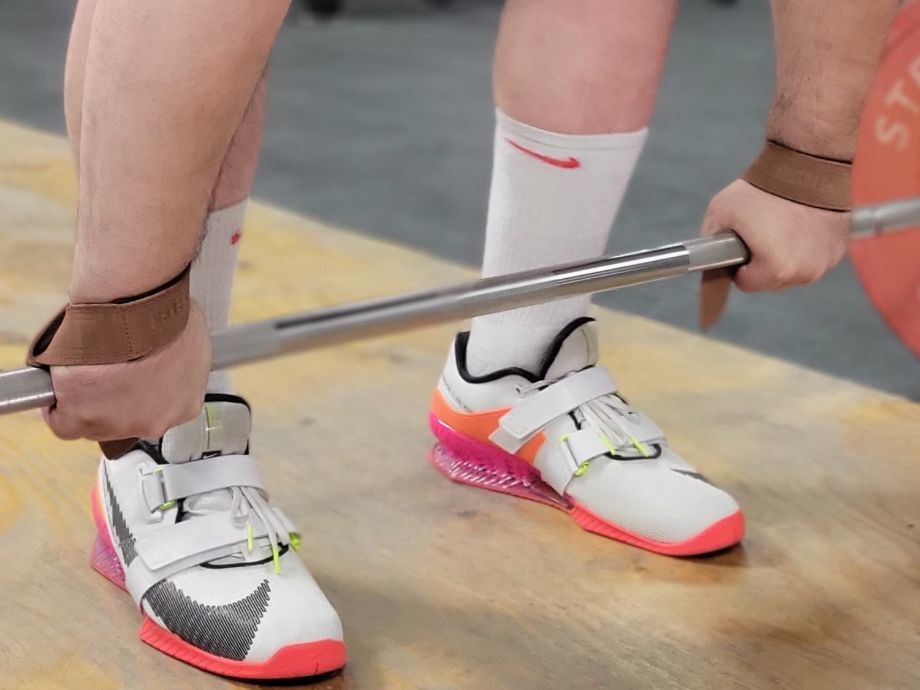
Keep Your Chest Up
When you reach for the barbell in the starting position, it can be tempting to drop your chest. You don’t want this because it’ll mean that your shoulders are rounded and too far forward. Instead, to keep the bar as close to your body as possible during the lift and make the exercise as easy as possible, lift your chest up.
Sumo Deadlift Benefits
This is what you’ve been waiting for—the benefits of the sumo deadlift. In my opinion, these are the three the most important:
Friendlier On The Lower Back
I loved doing regular deadlifts until I started lifting heavy on them, and then they started aggravating my lower back. I didn’t want to add any more weight to the bar because of this, causing me to plateau. Sumo deadlifts changed the game. Because you’re more upright during the exercise and closer to the floor, this can help to ease the pressure on your lower back.
You May Lift Heavier Loads
Because your arms and hands are on the inside of your legs, rather than the outside like the traditional deadlift, this gives you a shorter range of motion. Why is this important? Well, this shorter range of motion usually translates to heavier loads during the sumo deadlift. This could mean more muscle growth.
RELATED: How to Deadlift Heavier
Easier For Taller People
A 2019 study in the Journal of Sports Science and Medicine3 found that the sumo deadlift was slightly mechanically advantageous for individuals with longer torsos, while the conventional deadlift may be better suited for those with shorter torsos. Of course, everyone is different, so it’s worth trying both to see which works for you.
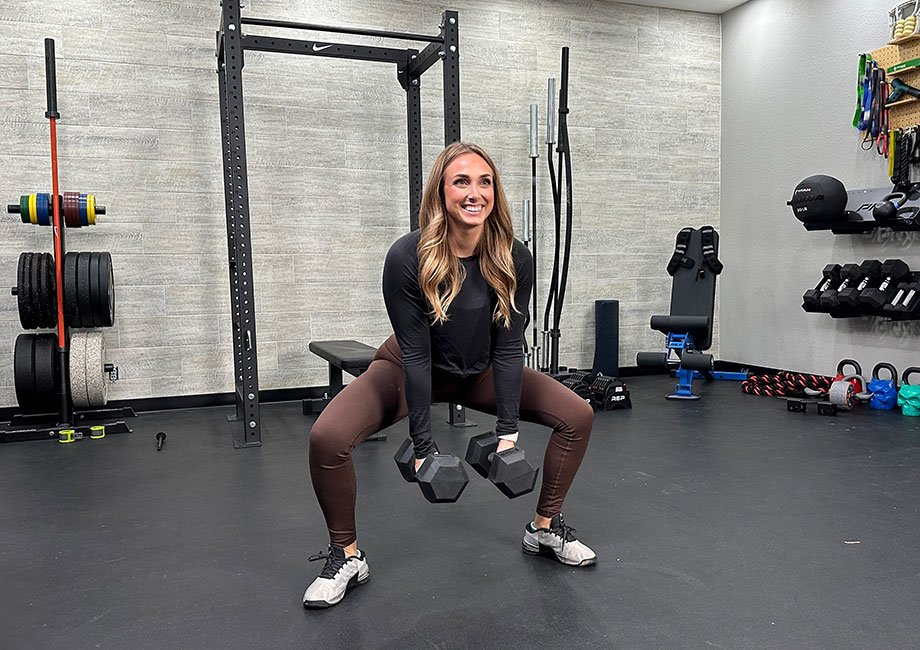
Common Sumo Deadlift Mistakes
It’s easy to make mistakes on the sumo deadlift. Luckily, it’s just as easy to avoid them. Two of the most common mistakes include:
Bar Is Too Far Away
The further the bar is away from your legs, the more difficult the sumo deadlift. When you set up, you’ll want the bar to be close to your shins. But even during the lift, it can be easy for the bar to move away, usually because your chest isn’t sticking up or your hips rise too early. Don’t make the lift harder than it needs to be. Keep the bar as close as possible.
RELATED: Deadlift Muscles Worked
You’re Hyperextending Too Much
At the top of the movement, time and time again, I’ve seen people hyperextending too much. This isn’t necessary and can put pressure on your spine. You want to end the movement by standing upright with your glutes squeezed, but you don’t want to be leaning backward at all. Being mindful of this can help to avoid injuries, especially with heavy loads.
Sumo Deadlift Variations
I believe it’s important that you have some variations of the barbell sumo deadlift. For example, you might not have (or want to use!) a bar and prefer to use dumbbells, kettlebells, or resistance bands instead. Alternatively, you may want to add an extra element to the movement to work your upper body.
RELATED: Upper Body Workout At Home
No problem! Below are four of my favorite sumo deadlift variations:
Dumbbell Sumo Deadlift
Why do it: It’s a great way to target the same muscle groups as the sumo deadlift without needing a barbell and weight plates. You also get a slightly longer range of motion with the dumbbell sumo deadlift, which has the potential for more muscle growth.
How to do it:
- Place a pair of dumbbells on the floor. Stand close to them in a wide stance with your toes pointing slightly outward.
- Bend at your knees and hips to take hold of the dumbbells, ensuring your arms and hands stay inside your stance. You’ll want an overhand or neutral grip here.
- Engage your core, keep your chest upright, and drive through your feet to lift the dumbbells.
- When you reach lockout, pause before lowering the dumbbells back to the starting position.
- Keep going for repetitions.
RELATED: Best Weight Plates
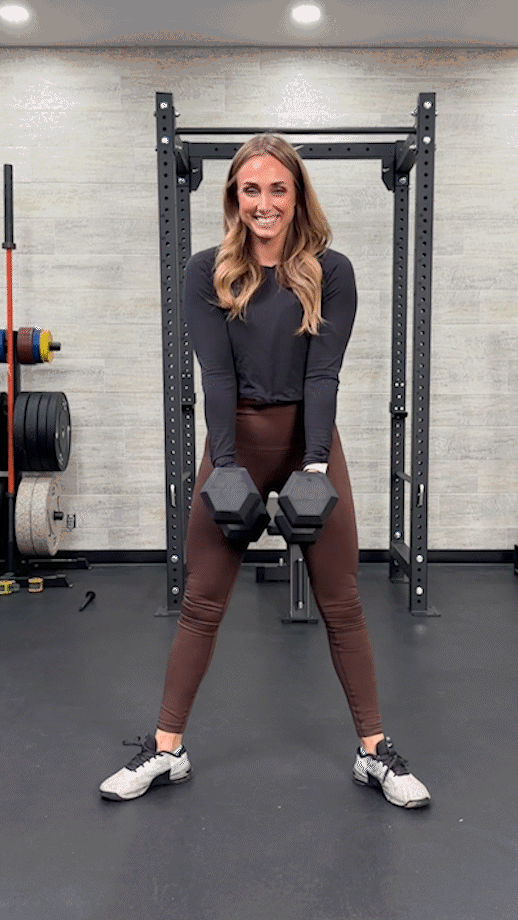
Kettlebell Sumo Deadlift
Why do it: For those new to strength training, the kettlebell sumo deadlift is an excellent way to learn the sumo deadlift technique before you progress to the barbell version. If the below is too easy or you don’t have a heavier kettlebell, use two kettlebells and hold one in each hand.
RELATED: Best Kettlebells
How to do it:
- Get into a sumo stance, with your feet wider than shoulder-width apart. You’ll want a single kettlebell in between your feet.
- Grab the kettlebell with both hands by bending at your hips and knees.
- Begin the lift by pushing your heels into the floor, ensuring that your core is tight and your chest is sticking up. You’ll want a neutral head position also.
- Squeeze your glutes at the top. Hold for a moment, then return the kettlebell to the floor in a controlled manner.
- Repeat for reps.
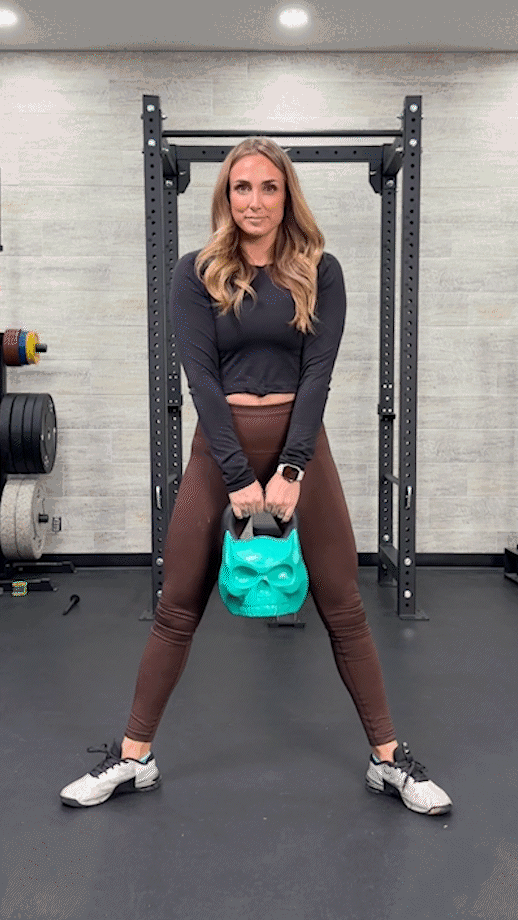
Sumo Deadlift High Pull
Why do it: Not only does it work your lower body with the sumo deadlift element, but the high pull section hits your upper body, too (especially the upper back, shoulders, and arms). It’s a popular CrossFit exercise, but it’s important to start light to get the proper form.
How to do it:
- Add your preferred plates to the bar, then step underneath it in a wider stance than a regular deadlift. Your toes should be pointing outward.
- With your arms and hands inside of your legs, take hold of the bar with an overhand grip.
- Lift the bar off the ground by pushing through your feet.
- Instead of stopping at the pelvic region as you would with a sumo deadlift, pull the bar to your chin. You’ll want to squeeze your traps here.
- Drop the bar to your pelvic region, then bend at your hips and knees to place it back on the ground to finish the movement.
- Keep going for repetitions.
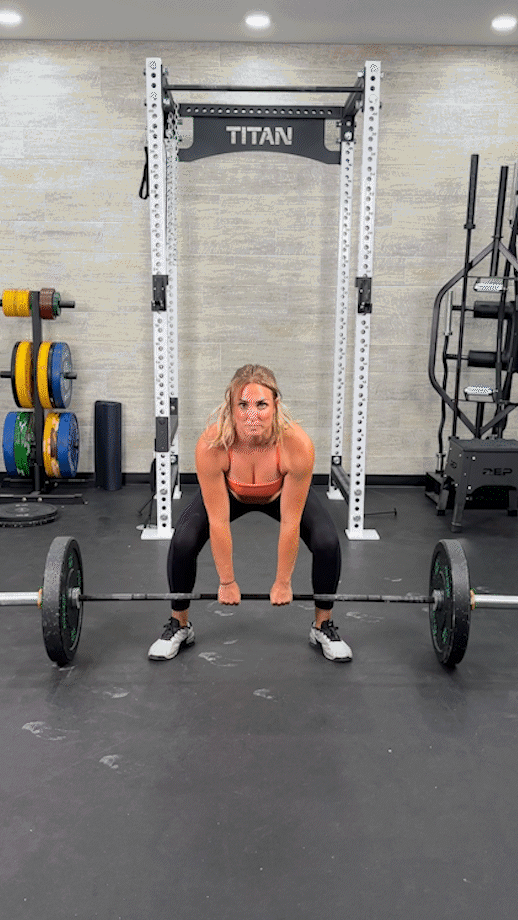
Resistance Band Sumo Deadlift
Why do it: If you don’t have access to barbells, kettlebells, or dumbbells, don’t worry! You can do the sumo deadlift using resistance bands, too. You can take these with you wherever you go, and they’re great for beginners or those who have injuries because they’re lower impact.
How to do it:
- Loop each end of the resistance band around each foot.
- Spread your feet out until you get into a comfortable, but wide foot placement.
- Bend at the knees and hips and take hold of the resistance band with an overhand grip.
- With your core braced, drive through your feet to get into a standing position. Pause, then go back to the original position.
- Continue for the desired number of reps.
RELATED: Best Resistance Bands
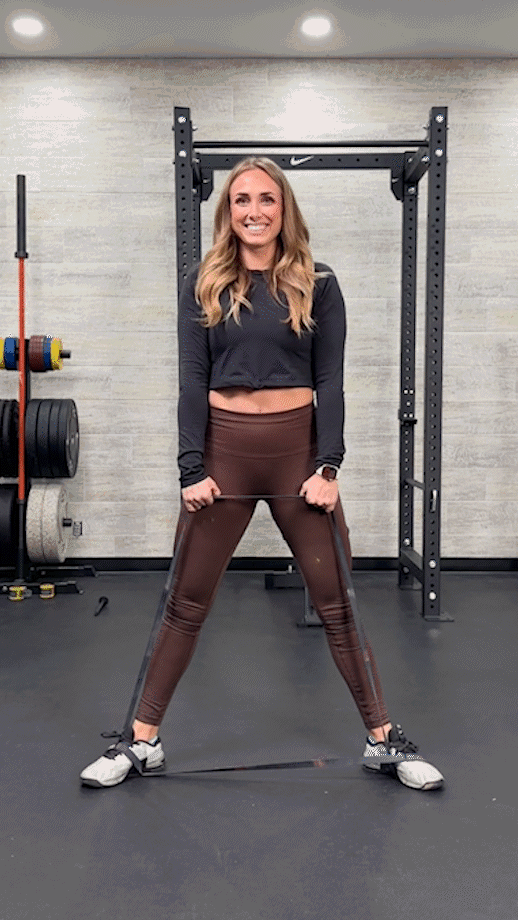
Useful Sumo Deadlift Equipment Accessories
You’re probably thinking, “All of this sounds great, but are there any accessories I can use to make this bodybuilding exercise easier?” From experience, here are a few:
A Deadlift Bar
Most lifters use a traditional Olympic bar to do sumo deadlifts. There’s nothing wrong with this. But if you want to take it a step further, a bar such as the REP Fitness Hades Deadlift Bar has a thinner shaft diameter and aggressive knurling to provide a great grip for heavy sumo deadlifts. With deadlift bars, you usually get a longer barbell length, too, allowing for more flex as you pull.
Deadlift Shoes
The best shoes for deadlifting can make all the difference to your sumo deadlift. I’ll be honest—I prefer deadlifting without shoes (as do a lot of the GGR team). But unfortunately, most gyms don’t allow this. A quality pair of shoes offers good ankle support and stability and are comfortable, durable, and have a stable base.
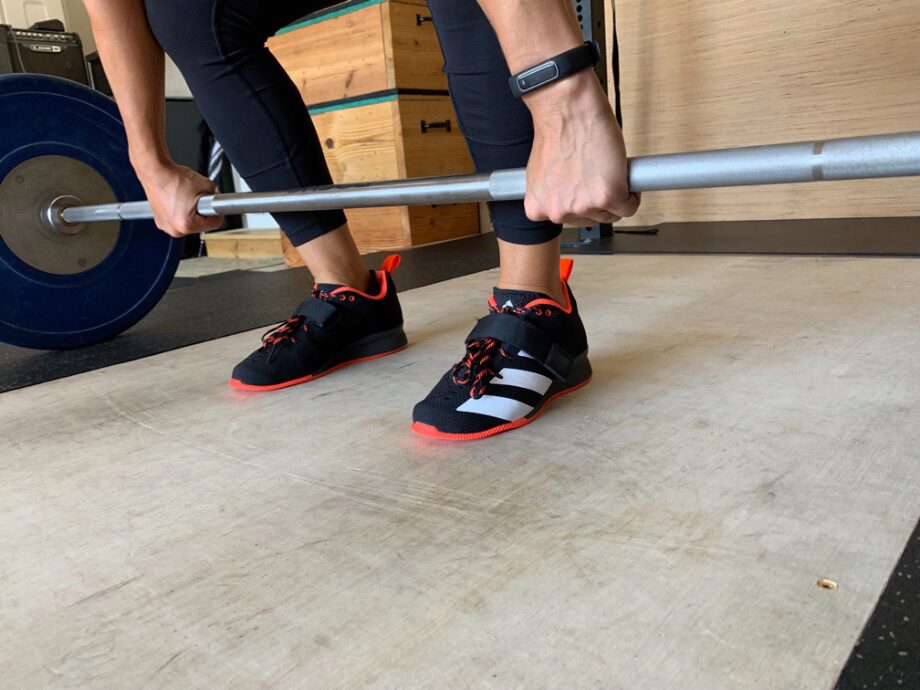
Weightlifting Belts
Some people love them; some people hate them. Yes, I’m referring to weightlifting belts. I’m in the “love” category if you’re wondering, but there’s a caveat. I would only start using one after you’ve had some experience training without one. Master your sumo deadlift form first, then use a belt to support your abdominal and back muscles during near-maximal loads.
RELATED: Best Weightlifting Belts Guide
Lifting Straps
When it comes to improving your grip strength on the sumo deadlift, consider a pair of the best lifting straps. Straps support your wrists, protect your hands from calluses, and, more importantly, may help you push through those extra few reps to help you build strength and size. Make sure you don’t over-rely on them, though.
Sumo Deadlift: FAQs
What are sumo deadlifts good for?
Sumo deadlifts are good for activation of the lower back, glutes, hamstrings, quads, calves, and trapezius. Some people (including myself) find that sumo deadlifts put less pressure on their lower back compared to regular deadlifts, which is why they include them in their workouts. You may even be able to lift heavier weights with sumo deadlifts.
What is the difference between sumo deadlift and regular deadlift?
There are a few differences between sumo deadlifts and regular deadlifts. Firstly, the set-up is different. With the regular deadlift, you stand hip-width apart and take hold of the bar with your hands outside your legs. With the sumo deadlift, you stand wider than this (around two times shoulder-width) and grab the bar with your hands inside your legs.
Because of this, the starting position of the sumo deadlift is more upright than the conventional deadlift, putting less strain on the lower back. As a result, the sumo deadlift requires the legs more than the regular deadlift to lift the bar. Finally, the range of motion is different—the regular deadlift has a longer range of motion compared to the sumo deadlift.
Can you lift heavier with a sumo deadlift?
Yes, most people find they can lift heavier with a sumo deadlift. This is because of the shorter range of motion that you get. It’s worth noting that every individual is different, and I know people who despise the sumo deadlift and find they prefer how the regular deadlift feels (and so lift heavier on it). Try both to see what you like.
RELATED: How to Lift Heavier
Which deadlift is best for glutes?
For the glutes, all types of deadlift work. This is because they all activate the glutes to some extent. Examples you should consider trying include the traditional deadlift, sumo deadlift, Romanian deadlift, trap-bar deadlift, single-leg deadlift, and deficit deadlift. Experiment with these exercises (and more) to see which works your glutes the most.
RELATED: Kettlebell Workouts for Glutes
References
- Yoke, Mary M. M.A., M.M.. What Are the Best Weight Room Exercises for Increasing Energy Expenditure?. ACSM’s Health & Fitness Journal 20(3):p 28-30, May/June 2016. | DOI: 10.1249/FIT.0000000000000203
- Fischer SC, Calley DQ, Hollman JH. Effect of an Exercise Program That Includes Deadlifts on Low Back Pain. J Sport Rehabil. 2021 Feb 24;30(4):672-675. doi: 10.1123/jsr.2020-0324. PMID: 33626500.
- Cholewa JM, Atalag O, Zinchenko A, Johnson K, Henselmans M. Anthropometrical Determinants of Deadlift Variant Performance. J Sports Sci Med. 2019 Aug 1;18(3):448-453. PMID: 31427866; PMCID: PMC6683626.
Further reading

From heating and compression to rolling and kneading tools, our team of experts try out and pick the best foot massagers for all your recovery needs. Read more

In this guide to bulking vs cutting, a nutrition coach explains the difference between these two dietary strategies. Read more

Wondering, "How many calories should I eat per day?" Get tailored advice from a dietitian here—because the 2,000-calorie guideline isn't one-size-fits-all. Read more

Flex Wheeler's Back Widow is one of the most versatile cable machine attachments ever created. It's great as a "back blaster" for lat pulldowns and rows, but works just as well for curls and tricep work. In addition to that, it doubles as a deadlift jack and also works as a landmine. Honestly, unless you're conscious of all it does, you'll forget just how often you can use it. It is expensive and we do recommend it, but only to those that will use it's various capabilities and don't want to take up space with a ton of different attachments. Read more

